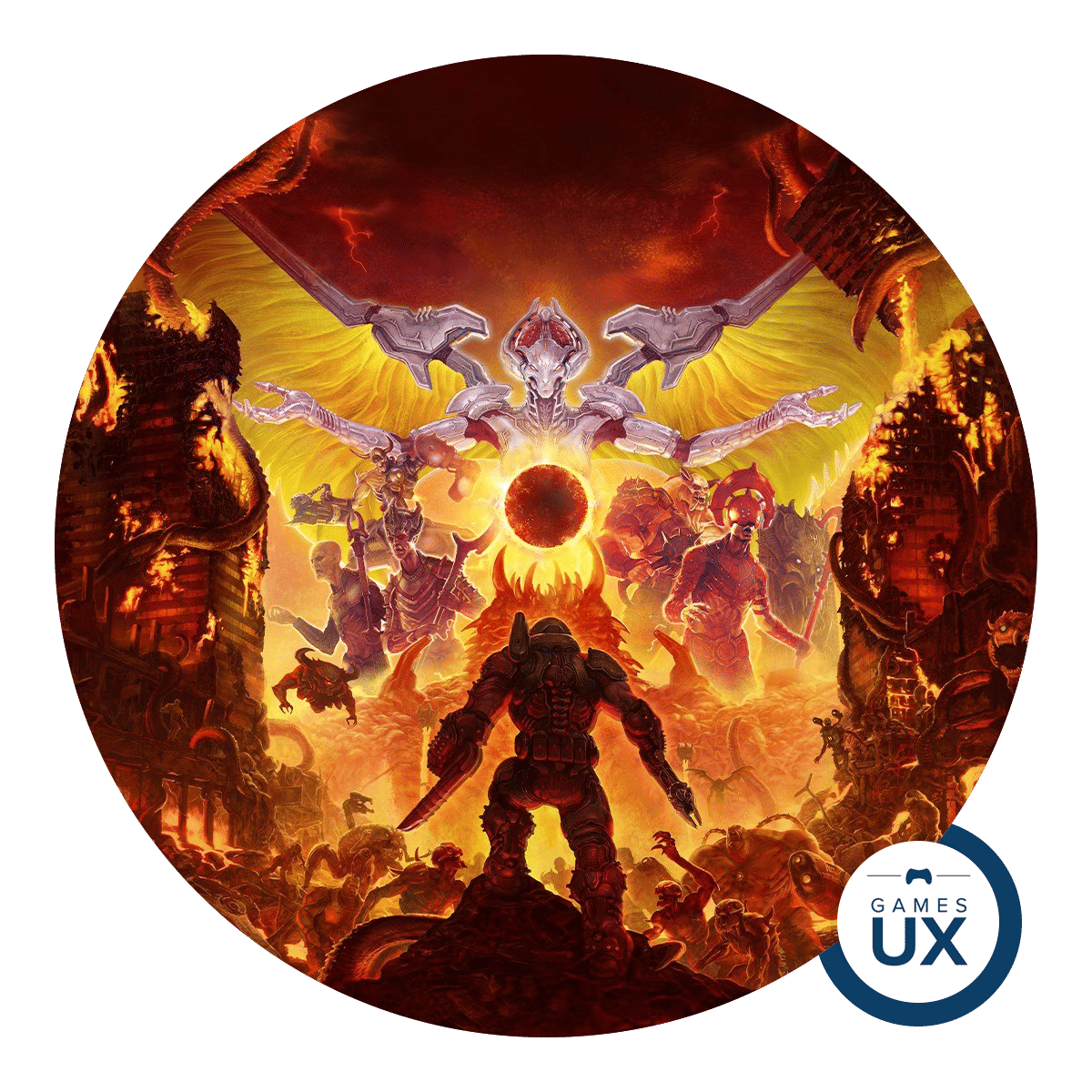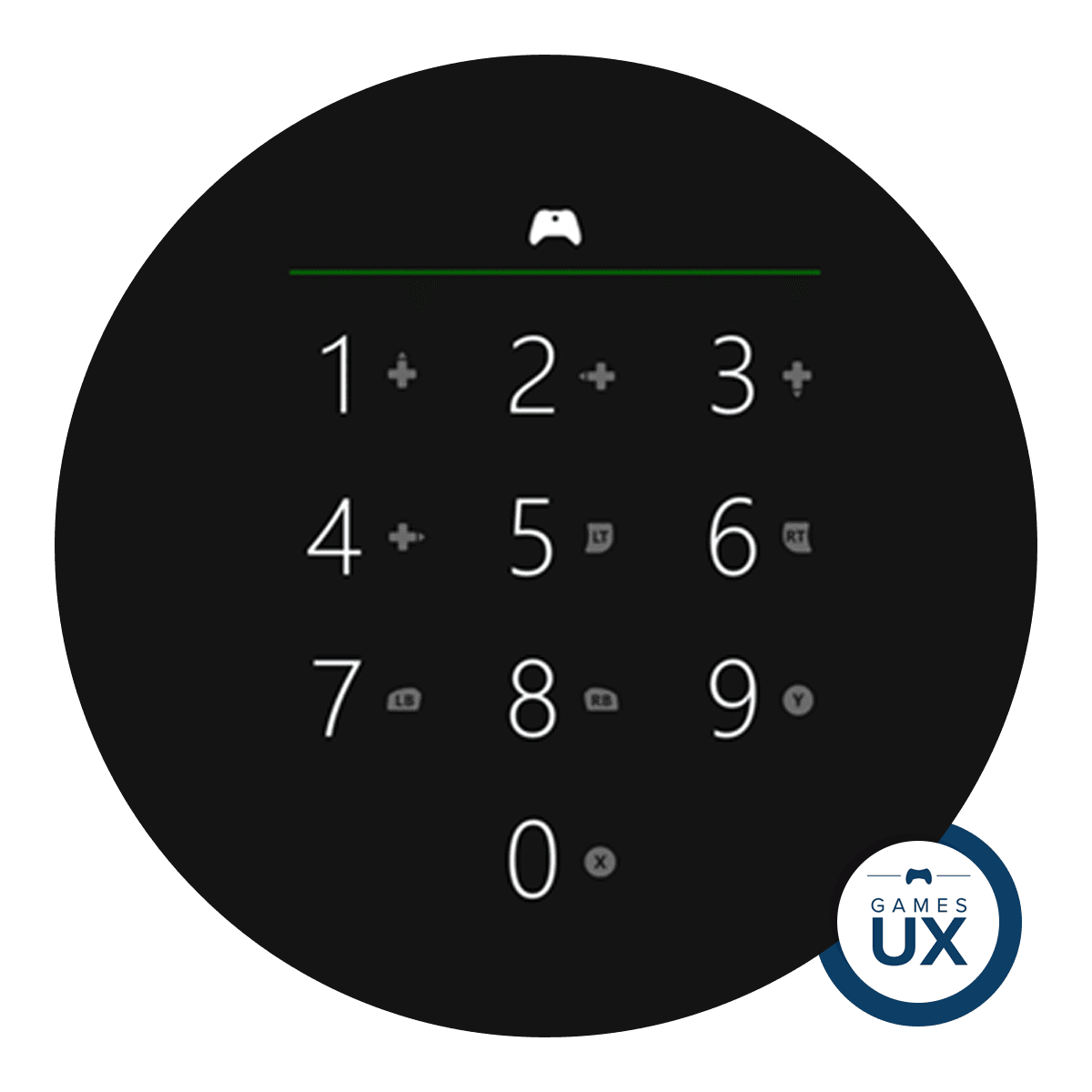Analysing the onboarding experience for new players in Doom Eternal

How do you become the Doom Slayer? Onboarding a new player to any game is an important design challenge for game developers, but it can be especially challenging in games like Doom Eternal. The development team needs to ensure that the experience is finely balanced for both totally new players and longtime series veterans. In this Games UX piece, I take a closer look at the learning process behind Doom Eternal’s first mission, and how the game introduces itself to players more generally.

Letter
Doom Eternal 101
Doom Eternal is a first-person shooter developed by id Software and published by Bethesda Softworks. The player becomes the Doom Slayer, tasked with a mission to stop Hell’s devastation of the Earth and the extermination of humanity. With a variety of armour, firearms, melee weapons, and other awesome weaponry, the Doom Slayer battles the forces of Hell at a hard and fast pace. The game pushes players even further by supplying health, ammo, and armour if the players aggressively battle the enemies, as a proper Doom Slayer should.

Doom Eternal is fast and bloody, and everyone loves Doom for that. Good UX helps create this experience.
The UI elements on screen have great contrast in all environments and are easy to scan. You have instructions on infrequently used actions — for example, the chainsaw (which can only be used if it has gasoline) — always displays its controls on screen, which is different from other weapons. Everything you need is there on the UI for you to quickly check and make fast decisions. There are also environmental cues, items, and enemy locations that guide you through the map and through the story.
The music and sound are utilized as an essential part of quickening or slowing the pace — the right soundtrack at the right moment engages players on a rampage. Unmistakable sound cues help the player manage rewards obtained during the rampage without losing the raw speed of battle. By contrast, the pace is slowed when you enter a platform puzzle with less intensity on the music.
These and more create a great experience where the player can focus on the main game task (and appeal): Rip and Tear until it’s done. Even with the platform puzzles, more focus on story or enemies that demand a little more brain usage and less rampage, compared with the previous title in the Doomseries.

Play conditions
This analysis was based on multiple people playing Doom Eternal. They all played the game sitting in a comfortable armchair in front of a 40-inch TV, between 1.5 and 2 meters away from it. This was done purposefully, as it was important to give them the same conditions with which to compare their experiences.
My lab rats have never played Doom Eternal. They are different types of players: from people that play multiplayer online games to people that only play Mario Kart on Christmas and had never played a shooter before.
I sat a few of them down and told them to play the first 30 minutes of the game. I wanted to see them play the first mission and understand how it teaches both new and experienced players.
Learning how to play with Hell On Earth
So, how do the participants learn how to play in the first mission? First, I should say that the intro is an excellent mood-setter. The Doom Slayer is conjured and given a mission — the player is being called to become the Doom Slayer and save Earth. As the camera approaches Earth, we slowly see and hear Hell’s invasion as it comes closer to us. From the calm and silent environment of The Fortress of Doom (a space station that the Doom Slayer uses as headquarters), our protagonist also watches the destruction and hears the calls for help from Earth becoming more and more desperate.
It’s a quick and straightforward way to set the player’s motivation and to engage the player at an emotional level. Not only does it give the player confidence and determination by marking you as the Doom Slayer and putting you in the character’s shoes, but it also provides the player with an emotional connection to the humans that are suffering on Earth.

The player is teleported to a small room with 3 zombies and goes through different challenges that gradually introduce weapons, game mechanics, demons, rewards, etc…
What helps players learn the game?
After testing with a few more casual and experienced players, I registered 10 main points that help them learn the game during the first mission. My main focus analysing their experience was to understand how the game helps the players learn what they need to fulfill their mission objectives.
1. Start with a simple HUD and add complexity throughout the game
This first learning stage lets players get familiar with the HUD through a simple introduction (image 3) that becomes more complex as the game advances (image 4). The game starts with just a very slow zombie in front of you (and 2 hidden that did not notice you yet). This allows players to check the HUD quickly; most players noticed the health and the amount of ammo available while still in this room. The amount of ammo is the easiest one to read since the icon represents two shotgun cartridges. The shields were only noticed by a more experienced player.


2. Colours grouped by meaning
Colours are grouped by their meaning which helps players understand every new item on the screen. The colour code is taught right in the cutscene intro. Red is for demons, for damage, that covers the Earth. Blue is the prominent colour of the “safe” place Fortress of Doom: used on lights, on the UI of screens, and also used to teleport the character. Immediately the player learns blue is safe.

Right after that, the HUD teaches the players to relate reward colours with the items that can improve the stats on HUD (image 6):
Green — Shield
Blue — Health
Orange — Ammo

Colours are also crucial for navigation and are quickly learned starting with the very first room. If a door is red you can’t pass, but a green door lets you can pass. A yellow marker that points you to a path through the room is also easily spotted. The game’s designers also took pains to ensure that the HUD and reward colours contrasted with those used throughout the world, making it easier for the player to see and understand.
3. Easy to navigate and colour code for navigation
After the first room with 3 zombies an objective pops up, showing “Get to Deag Nilox’s Chambers”, and the first navigation marker appears with the distance in meters labeled bellow the marker icon (image 7). This marker is always on screen, and the direction is adjusted based on the indication on the top-centre of the HUD.

Given the visual similarities of this component of the game to symbols used in real-life navigation items, casual players caught on to the idea very quickly. It was also beneficial for less experienced players that had some trouble controlling the character’s movement in the first rooms.
Given that shield rewards and the available passage/door both use green, the game uses small breadcrumbs of shield rewards to guide the player (image 8). Usage of the green colour is especially effective with new and casual players, given the standard usage of the colour in our daily lives is for “go” and is also a positive reinforcement feedback colour. If it’s green, they know they can go.


4. Pop-ups with tutorials and a safe place to practice
The tutorial pop-ups were very welcomed by the less experienced players. They enjoyed the explanation and tried to memorise the info. Some pop-ups can only be closed if you use the button approached on the pop-up — these were the most effective ones teaching new players.

The first pop up explains how to use R3 to glory kill (image 9), and it was entertaining to see some of the players use R3 for almost everything they could because the glory kill was so much fun. But only one player was able to take consistent advantage of the R3 for effective glory killing in the entire mission.
Some pop-ups were followed by a safe tutorial room (image 10). The first one was the chainsaw. Having a safe room to reinforce (3 times!) the usage of the chainsaw and the rewards you can get from its use was important for all players. Some focused on how quickly and safely they could kill a demon, others on the stupid amount of rewards that it gives you.

The composition of the pop up was vital to teach players; a clear title that describes the action, an animation demonstrating the action and text explaining how to perform the action. The text was white except for the yellow that states the action the player needs to perform on the controller followed by the blue for the resulting action in the game. Players with no time or patience to read the entire text still read the yellow and blue text and it is enough to learn the necessary info.
On the bottom of the pop-up, you have the instruction to close the pop-up with all letters uppercase.

5. Easy to find rewards
Rewards are easy to spot, even if you are running around in full rampage mode. The ammo for the shotgun in the first room was noticed by all players except one (image 12). In the game’s defence, I know this lab rat to be very energetic and not at all observant.

In all rooms, the colours, large size, and illustration of rewards are very clear and easy to read and find.
6. Gradually introduced weapons (and upgrades) followed by new demons and challenges to test them
The demons that are first introduced are easy to defeat and don’t deal much damage; they are appropriate to the learning phase. First zombies, which help you learn to shoot, do a glory kill, and use the chainsaw. As you get acquainted with the basic mechanics of the game, you are introduced to a big room with zombies, imps, and soldiers. This is where you are introduced to the pace of the game and the possible future challenges. Soldiers are slower, imps are faster, with both types more difficult and capable of dealing more damage than zombies. You get to fight them again and again until the next big room, and a new demon shows up that adds to the pile of enemies, and so on.

The new demons usually come with a specific challenge, thus for you to kill them you need to use a particular weapon and/or strategy. The game introduces you to what you need to know or own to overcome this challenge right before you encounter the demon (like the example on image 13). Players were able to understand the specific challenges of the different demons not only in the first encounter after the “introduction” but also in subsequent encounters.
Understanding, in some cases, did not equal results; some had difficulties doing what was necessary due to lack of experience playing these types of games. Given enough time, though, they were able to do it.
7. Required pace and strategy are taught quickly
This was a fascinating point to observe on casual players; they did not know Doom or games enough to read the game quickly and try to follow the game’s leads. So they tried to run away, hide, to use some stealth. The game forces you to learn that you need to actively fight against the demons; your mission is to kill them all.
Since this is done from the very first room, all players pick up the game pace very quickly except when things get difficult again, and they die. It’s when they compare “if I run I die” vs “if I kill I win health, ammo and shields” that they learn the true lesson the game is teaching, in the first big room with zombies, imps and soldiers. Some of them take more time to learn it, but since everything is gradually introduced, it doesn’t get frustrating because they feel like they are learning to beat the game.
8. Start and end in a safe place
The player starts in a safe and quiet location, the Fortress of Doom, and is teleported to Earth immediately with a zombie right in front of you to kill with a combat shotgun.
Starting in the Fortress of Doom gives the player a sense of safety, to have a place to go if something goes wrong. It feels safe for new players to know this place exists; it helps boost your confidence going through the first level. If you think about the flow of the game and the pace it demands from players, just starting there is a good way to not lose the players in the sense of destruction.

All of this is reinforced by teleporting the player back to the Fortress of Doom at the end of the mission.
9. Exploration items, collectibles, and puzzles for experienced players
The first mission has a total of 13 items on the map, 4 of which are secret collectibles (3 toys and 1 cheat code). Almost all the players I tested with did not notice the question mark on the map or the game world. One saw a floating question mark (image 15) but gave up trying to solve how to get it. Despite that, he was keen on reading the codex and understanding more deeply how to use and upgrade weapons. Only an experienced player was able to get at least two secret items as they enjoyed exploring and learning a bit more than other players.

More experienced players do enjoy learning and exploring a bit more of the game since they believe that knowing a bit more would help them master the game — “You never know what can help you”, one said. These extra challenges are good to keep them satisfied at this starting point where the challenge is still not significant for them.
10. Guns and other bloody fun on the first battles with demons
Fun is always important, even if it is fun in the form of a bloody spectacle that can be a bit too much for some people.
The shotgun, as I said before, is a good starting weapon given the amount of damage it deals and how friendly it is for new and casual players. But it’s also fun, and it provides an excellent introduction to the game’s gory nature. The first thing the players learn from the pop-ups is a glory kill — a kill that gives you extra health but also is a more gruesome and picturesque way of killing than with a shotgun. Then the chainsaw appears to add even more to this core idea of Doom as a bloody spectacle.

Even in the cutscenes, small details like adjusting the crown of the dead Hell priest give a bit more to this fun side of the game.
What would I improve and how?
1. Enlarge text size in pop-ups if players enlarge HUD size
I’ve talked about this in other reviews and, with credit to Doom Eternal, it is possible to enlarge the size of the HUD, but not the size of the text within the pop-ups. Some players adjusted their sitting position to read the pop-ups and still said it was hard to read.
Why should it change?
- Tutorial pop-ups are essential to teach players during this learning stage. If they miss the info, they can get killed, and/or they will need to stop the flow of the game to check on the menu the info.
- These pop-ups are very well organized to teach players effectively; it’s a waste if they can’t read it.
What would I do?
Enlarge the text size of the pop-ups IF the players enlarge the HUD size on the settings.

2. Use the button described in the pop-up to close it
In some pop-ups, you need to use the button described in the tutorial. Those were the most effective tutorials for teaching players how to use them.
Why should it change?
- The pop-ups that use this strategy are more effective to teach players.
- Players got frustrated because the mechanic to close the pop-up changed without an apparent justification.
What would I do?
Always use the button described in the pop-up to close that specific pop-up. (image 17)
3. Provider more instructions if the player chooses the lowest difficulty level “I’m Too Young to Die”
I will use the glory kill pop up as an example:
As the first door opens a yellow marked zombie appears. It’s frozen in that yellow light, and the players need to approach it to see the first tutorial pop up. Almost all players tried to use the shotgun at first, but only experienced players understood that it was not possible to use it quickly and actually approached the demon to learn what was going on. Less experienced players kept using the shotgun, and since they had just learned to be quick to kill, they got confused, with one even saying “of course I will not get close to the demon”!
Another example: less experienced players did not know how to use the shotgun, and there are no instructions.
Why should it change?
- Less experienced players were not as likely to take risk actions during the game.
- Less experienced players do not know standards for actions with a controller.
- They already don’t know how to play and keep feeling like they don’t know and will not learn. The learning curve gets slower and therefore, more demanding.
What would I do?
I do like that the game forces players to get closer to the zombie to teach the glory kill, to take advantage of a more melee approach. This first glory kill is safe but still, some players did not do it. At this point and others, like the first shot and first double jump, there is a need for instructions to help players advance. I would say to apply this concept to the lowest difficulty level “I’m Too Young to Die” — have more instructions on-screen.

4. Soldiers more obvious that are demons
This one was the most surprising, finding that the soldier demon is not obvious as an enemy. The first time players see one, the soldier is fighting with an imp — players assume the soldiers are on their side (“they look like my character!”). Two things happened: players would go somewhere else to kill other demons (and later learn the soldier is not friendly) or they would help the soldier demon and get the surprise of their lives.
Despite the challenges to the player, this was really entertaining to watch.

What would I do?
I’m not sure if I would change this one because it also teaches players not to trust what they see during a demonic invasion. I would not change this one, but it’s a worthy mention and something that depends on what the game wants to teach. Maybe at this stage it does not make sense for some people but for me it did — do not trust anyone, kill or get killed.

Final thoughts
Doom Eternal creates a balanced learning experience that gives the players all they need to know to fulfil their missions and all the tasks required within the game. It might be bloody and brutal, but all of them had fun and enjoyed the time spent playing.
I would say it’s a great starter for new and casual players, as the game does a great job teaching and helping players to evolve slowly while keeping the fast rampage pace the game demands from you. It follows not only the game’s purpose but also the story and the character’s mood. It’s built like a full experience — being the Doom Slayer from the first time you are teleported from the Fortress of Doom until the end of the game…
Rip and tear, until it is done.






